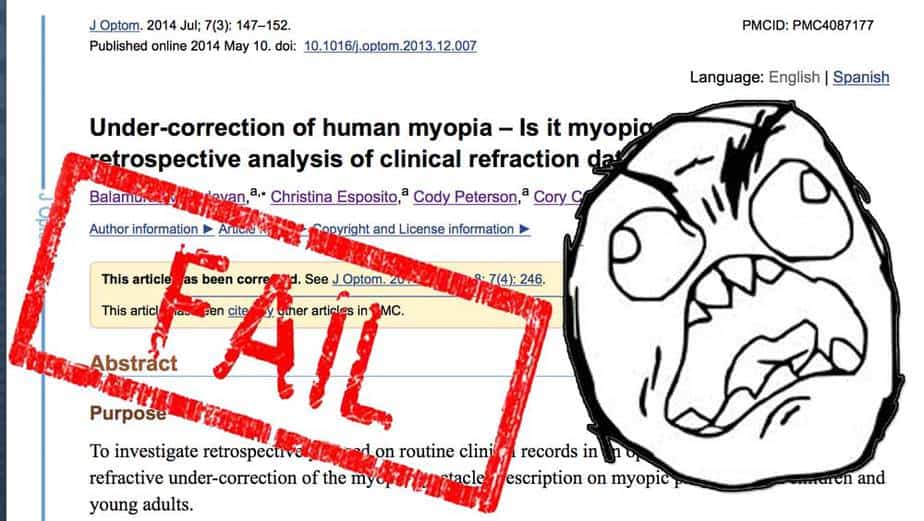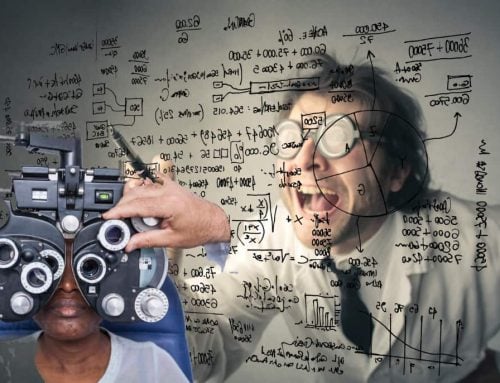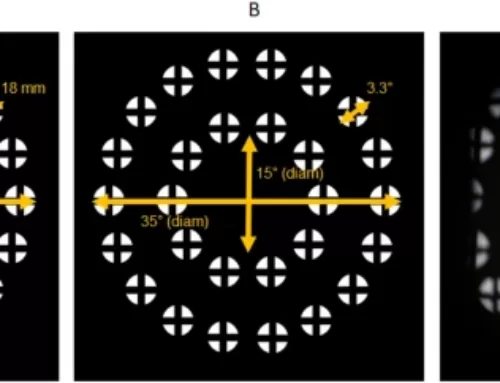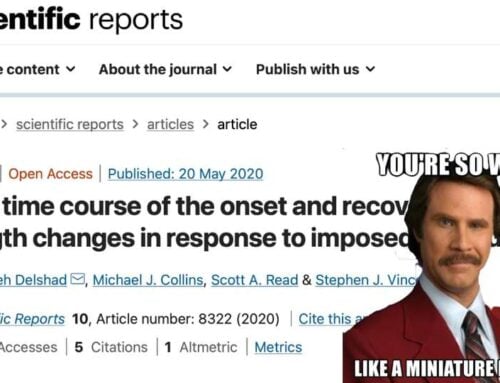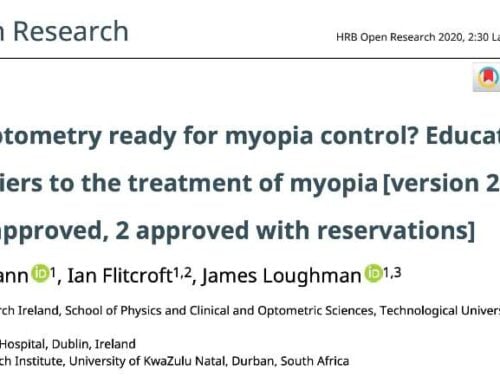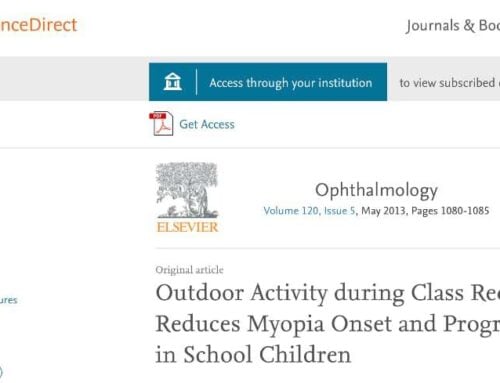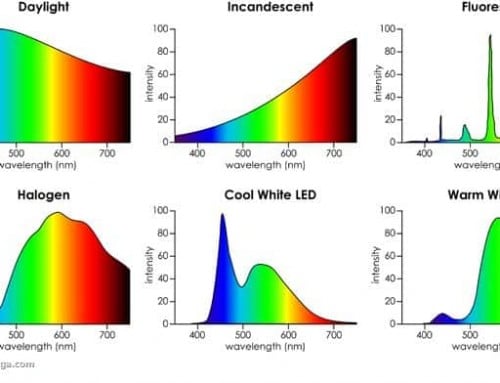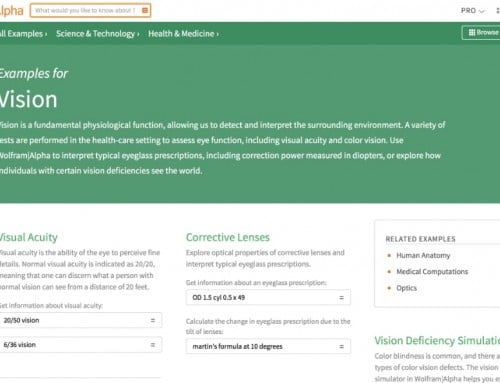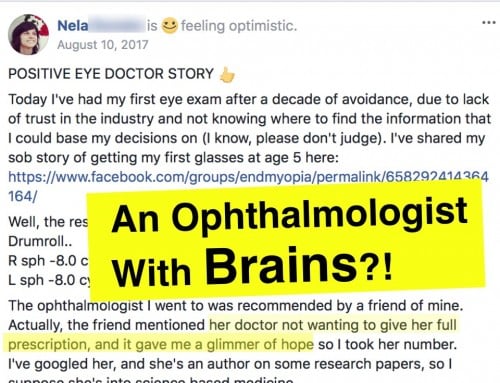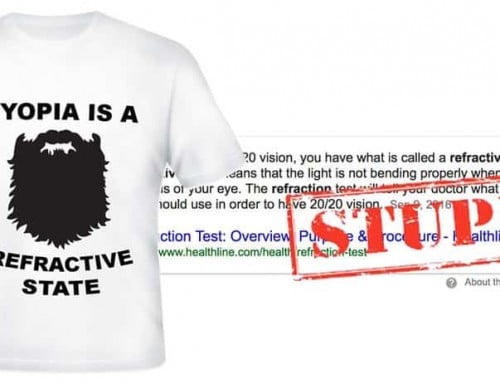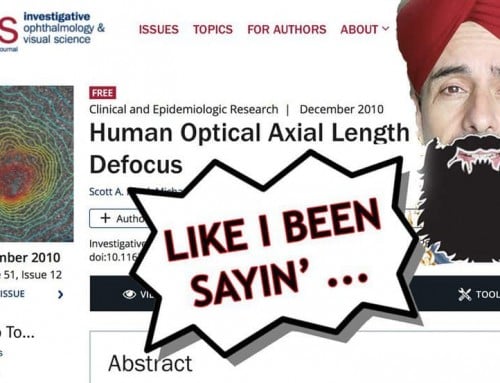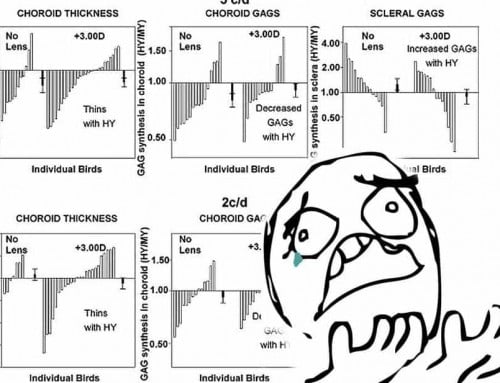Here’s today’s (pseudo?) science argument: Your glasses aren’t strong enough, so your eyes will get even worse. Fact, or fiction?
If you’ve been digging into myopia science (good on you!), you’ve probably come across Chung and his drum beating that undercorrection causes more progressive myopia.
One of the things most challenging about finding answers in scientific literature, is having to dig through nonsense. Faulty logic, poorly conceived experiments, lacking critical data, bias, and the ever-present excessive use of fluff-science-language.
You can’t just go to studies and skip straight to the results and analysis section. You have to read and then look at how the study was conducted and understand the full picture of what you’re reading. Was it funded by specific industry interests? Are the problematic logical fallacies defining a narrative? Is the data just plain sketchy, or are methodologies of tests and experiments poorly defined or inconsistent?
Let’s look at one of these studies:
Under-correction of human myopia – Is it myopigenic?: A retrospective analysis of clinical refraction data
Things are about to get interesting. Will these guys really figure out if undercorrection causes more myopia? They say so:
To investigate retrospectively, based on routine clinical records in an optometric office, the effect of refractive under-correction of the myopic spectacle prescription on myopic progression in children and young adults.
Spectacle, indeed.
Patient records of children and young-adult myopes in a private optometric practice in Glendale, Arizona, USA, were initially reviewed to identify those that met the criteria. Information collected from the patient records included: age, gender, the dates and number of their visits (more than one visit was required for use of the data), final prescription, and non-cycloplegic subjective refraction. For each patient visit, the difference in spherical equivalent (SE) between the subjective refraction for maximum visual acuity and the final prescription was calculated for both the left and right eyes. Myopia progression was defined as the difference in SE between the final subjective refraction of the previous visit and that of the subsequent visit. Based on the study criteria, a total of 275 patient visits were obtained from the data collected in 76 patients.
You’re about to experience why your most illustrious eye guru is disinclined to write these missives, exploring certain types of studies.
I can’t dissect this one via copy-paste without making this a painfully long post that you’ll just skip reading altogether. So go here and read the full thing before continuing with my analysis (or download the PDF).
..
… (go read!)
..
Ready? Did you read it? Skim it at least? Click the link at least?
Let’s apply a bit of dissection to this one then. Feel free to go back and re-read the “study” with fresh eyes and added perspective. Thing will start making a lot more sense.
Genetics & Progressive Myopia
Genetics plays a significant role in progressive, lens-induced myopia.
Ever wonder why some of your friends can play endless computer games and still have perfect natural 20/20, or while all the Asian kids seem to be wearing glasses?
That’s because, genetics.
Genes don’t cause myopia, but they certainly affect the susceptibility to axial elongation for equal amounts of stimulus. In other words, same circumstances, one person’s eyes get worse, the others don’t.
Tons of actual studies (1, 2) on that one. Just do a Google Scholar for “genetic myopia”.
Does this so-called study reference genetics, a huge part of progressive myopia, in any way. Of course not. It’s a flyover study, a lightweight effort, a fifth-grader with a science word randomizer and little insight into how to design a meaningful sample set.
Also and almost not even worth noting, out of 76 subjects, 61 were between 11 and 19. Progressive, lens-induced myopia progresses most rapidly in this age range, with a great deal of variability ranging from ethnicity to close-up distance, and close-up time.
So you say, whatever. 76 people, genetics should average out (*sarcasm*). I’m not sold, Jake, I think they make good points.
Let’s step it up a bit, then:
Where’s The Diopter Data?
That’s right. They say undercorrection, and they say subjective exams. But where are the numbers on actual diopter corrections, study-dudes? Show us the data on what actual prescriptions were given, based on the undercorrection.
All that key data is either missing, or at least I’m not smart enough to find it.
That’s only entirely central to their whole argument, and we’re what, supposed to take this on faith? It’s rather quite easy get incredibly annoyed with these studies, as you start reading and looking at the supporting evidence. Hey academic jargon writer guys, where is all the data?! Your graphs mean exactly nothing without the underlying data points.
Deep breaths. It’s still going to get worse.
The Correlation Question
The results they parade around show less than 0.25 diopter difference in progression between least and most undercorrection. Which incidentally is the smallest increment in lens corrections (because of course that’s all the data we work with here, because who’d bother exploring axial length deviations or anything beyond a retail lens shop’s crude increments of lens corrections?). This is either hilarious or just plain terrible.
And yes, you’re going to be more than just a little bit concerned about measurement error, given the subjective nature of the exam and interpretation of “adequate correction”, for which incidentally no method detail is included.
They even explicitly state that the measurements were subjective. Explicitly. I can’t overstate the irony of this point.
Moving on to bigger fish (and fallacies):
Actual Diopter Exposure Data?
This is where we cross over from perhaps negligent, perhaps lazy, perhaps lightweight study material, and into the unbelievable and just plain ridiculous. Ready?
Here’s the question: Where are the observations about net close-up diopters for the participants? This is a big one.
In other words, if you are undercorrected by 0.50 diopters but compensate by moving your screen to 30cm in front of your eyes, you are in effect massively overcorrected, compared to say someone who is not undercorrected (ie. less likely to develop significant bad close-up habits of this nature) who may stay at 50cm. Also of course, close-up times per day, not available, zero data on accommodation (ciliary spasm), we’ve got nothing here telling us anything about the participants eye’s strain and stimulus exposure or reaction to it, during the study.
Make sense? (Sure seems like video would be much more fun to go through all of this.)
Yea, their (subjective!) measurement says subject A is undercorrected. But progressive myopia happens from hyperopic defocus, which you get primarily when you use a distance prescription in close-up. So how long where these subjects in close-up, per day? How close were they to screens and pages? What’s the net, actual diopters they were exposing themselves to?
Nothing. Crickets. Our darling study writers don’t even once acknowledge the core concept of hyperopic defocus as driver of axial elongation (or even axial elongation, or anything not 5th grader lightweight work). They don’t mention the drivers of myopia and then they leave out all data on acual diopter exposure.
Makes your brain bleed, all of this.
But let’s be the devil’s advocate. Let’s assume you read this far, and you’re still skeptical. You say Jake, you’re adding constraints that could be argued either way. Maybe it’s not hyperopic defocus that causes progressive myopia.
So let’s get back to the clown show and dig further.
Think about this: What’s perhaps the biggest no-no on planet earth for any sort of study? Beyond skipping critical data points, or ignoring major factors to outcomes, or misrepresenting base terminology?
The biggest no-no you might say, is assuming causality.
As in, assuming that the undercorrection is what’s causing the progressive myopia. Because if that was just an assumption then the rest of the study, however lacking in critical data and making other assumptions all over the place, would just be complete garbage.
And they don’t disappoint us, on this count:
Assuming Undercorrection Cause
Here’s a curious question for you:
What happens when the individuals who are undercorrected, are given “adequate” correction? Would they stop becoming more myopic, faster?
Hmm, you say. Good question, Jake.
Did they go back and give the undercorrected, more rapidly myopia progressing subject the “right” correction later, and observe whether they stopped becoming more myopic at the more rapid rate?
Quick, without looking back at the study, take a quick guess whether this has been addressed.
Will you find any data showing that it’s indeed specifically the under-correction causing the increased myopia progression? No. That’s just mind boggling, truly. So they walked in, decided that undercorrection would be the problem, and built the flimsiest pretext of a “study” around this assumption. And would you know it, they found that their assumption proved correct!
You see why I don’t write critiques of this sort of thing?
Let’s throw in a “oh one more thing”, even if we’re well past making any points that matter.
Glasses Sales Shop Proves: More Glasses = Better
Let’s be gratuitous about this “study”.
Let’s ask: Where was this thing conducted, by whom, should we be in any way concerned about bias? (like it matters considering the heaping piles of assumptions and gratuitously lacking and misrepresented data).
Well, incidentally the study was conducted at a “private optometric practice”. What are the odds that it looked like this?
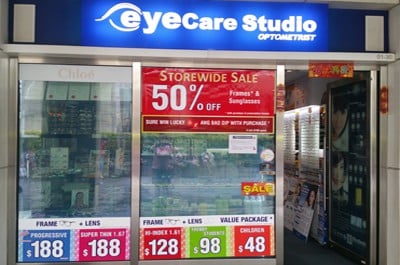
Where you conduct unbiased myopia studies.
Now granted, this is me just making assumptions.
And realistically, it’s perfectly ok to go to a place that sells a product and ask: “Hey, can we do a study using your shop to find out whether buying more of your product is good for the consumer?”

A science lab.
More could be said here, but this is the guru-limit on nonsense. Go forth and read, come to your own conclusions.
(the related FB discussion and for good measure, a study on what actually causes myopia progression to help flush your brain of all this craptastic nonsense)
P.S.: Here’s an actual decent study, showing something far more interesting. If you give already myopic children glasses, they get myopic *a lot faster*. https://endmyopia.org/another-study-glasses-cause-rapid-myopia-progression-in-children/
Cheers,
-Jake

